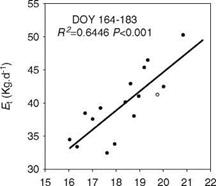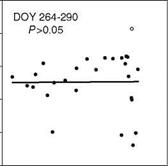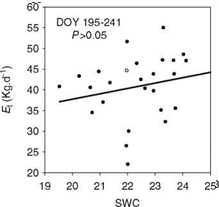Table 4.4 summarizes the relationships between the transpiration of Chinese pines and various climatic factors, including Ta, RH, PAR, D, and w, on multiple time scales. The sap flow rate in Chinese pines was highly related to the meteorological factors, but varied substantially with both growing season and time scale. For example, the trunk sap flow of the whole period was significantly correlated with PAR and D on both the 10-min scale and the 1-h scale, whereas the sap flow mainly depended on PAR and Ta on the daily scale and on Ta on the monthly scale. Similarly, the trunk sap flow of both the growth period and the dormant period was dependent on different climatic parameters at different time scales. The results suggest that the driving factors of Et on the 10-min scale were the same as those on the 1-h scale. The Et values at the 10-min, 1-h, and daily scales were highly correlated with PAR, whereas on the monthly scale, Et was mainly affected by Ta (whole period and growth period) or D (dormant period).
The diurnal variation pattern of Js closely matched that of PAR and D, and the correlation between Js and PAR was generally better than that between Js and D. For instance, on Julian day 118, the correlation coefficient (R2) between Js and PAR and Js and D was 86 % and 71 %, respectively. PAR and D together explained 94.5 % of the variation in Js. The diurnal pattern of Js in the dormant period was very different from that in the growing period in that Js was negatively related to
a b
|
D (Kpa) PAR (mmol. m’2.s’1) Fig. 4.4 Relationship between Et and (a) vapor pressure deficit (D) and (b) photosynthetically active radiation (PAR) on the daily scale |
PAR and D (e. g., Js = 0.0001-1.5083e-007PAR, R2 = 0.56, p < 0.0001; Js = 0.0002-0.0002D, R2 = 0.56, p < 0.0001 on Julian day 8). The results suggest that the shape of the diurnal flux in trees was mainly controlled by PAR, which might be caused by stomatal sensitivity to PAR. The research results are consistent with these on xylem water fluxes in ten tree species and two liana species (Phillips et al. 1999).
The day-to-day variation in Et of Chinese pine was largely a function of daily differences in PAR, D, and SWC during the growing season. Increases in average daily D led to plateau-like increases in Et [Et = 40.91(1 — exp(—1.30 x D), R2 = 0.54, p < 0.0001] (Fig. 4.4a), indicating stomatal closure, which is consistent with studies on individual 30-year-old Pinus sylvestris L. trees (Wang et al. 2005), ten tree species (Phillips et al. 1999), and in a tropical rainforest (Granier et al. 1996), whereas these results differ from a study on large red maple trees (Wullschleger et al. 2000). Increases in the average daily PAR led to near-linear increases in Et (Et = 12.21 + 0.06PAR, R2 = 0.59, p < 0.0001) (Fig. 4.4b). Daily PAR, however, had to exceed 100 pmol/m2/s before rapidly increasing rates of Et. A similar relationship was found by Wullschleger et al. in large red maple trees and by Zimmermann et al. in ten tree species (Phillips et al. 1999; Wullschleger et al. 2000).
When the rainy days were excluded, Et was significantly correlated with SWC10 with medium explanatory power and with SWC30 with less explanatory power (Fig. 4.5a). Specifically, three representative patterns between Et and SWC10 were identified (Fig. 4.5b-d). First, between days 195 and 214, it rained at an interval of a few days and SWC remained high (>19.5 %). During this time, the correlation between Et and SWC was not significant. This result suggests that with sufficient soil water, Et might be more sensitive to other variables, such as vapor pressure deficit, D, rather than SWC. Second, between days 164 and 183, after a first occurrence of 55 mm of rainfall, SWC increased to 20 % and then dropped again.
![]()
![]()

![]()
![]()
![]()

 |
|
40
30
20
10
0
Fig. 4.5 Correlations between Et and SWC10 (a) excluding rainy days during (b) Julian days (DOY) 195-241, (c) Julian days 164-183, and (d) Julian days 264-290 on the daily scale
The correlation between Et and SWC was significant, indicating that the transpiration was affected greatly by SWC. Third, between days 264 and 290, no rainfall occurred and SWC remained low (<15 %). The correlation between Et and SWC was not significant, which suggests that soil moisture was not the key factor regulating transpiration during this period. PAR and SWC together explained 74.3 % of the variation in Et.
Meteorological factors affect instantaneous variability, whereas SWC determines the general level of tree sap flow (Huang et al. 2009; Liu 2008; Phillips and Oren 2001). SWC was a very important factor for Et in the Chinese pine, particular after a rainfall followed by no rain for a few days. However, in a related study in a mixed forest of Chinese pines in suburban Beijing, sap flow showed a trend of accelerated growth when SWC increased from 4 % to 14 %, whereas the
|
Table 4.5 t test of characteristics of three sampled trees between 2008 and 2009
Ac indicates canopy area |
increase slowed down when SWC was greater than 14 % (Liu 2008). This slowing trend in sap flow was not observed in this study, which may be attributable to the soil water availability of the study site.
According to previous studies, the factors affecting interannual variability in transpiration are mainly growing season length, soil drought (Yoshifuji et al. 2007), leaf area dynamics (Phillips and Oren 2001), rainfall (Limousin et al. 2009), and compensatory mechanisms linking annual rainfall, leaf area index, and tree water use (Melanie et al. 2006). In our study, the sampled tree characteristics, including As, Ac, and LAI, and most environmental factors were similar in the two different years (Tables 4.2 and 4.5), whereas precipitation differed significantly in 2008 and 2009. Because of irrigation, soil water content was not exclusively affected by the amount of precipitation, and irrigation effectively offset soil drought (Fig. 4.1). Therefore, there was no significant decrease in soil moisture content in the dry year of 2009. These results indicate that soil moisture content was the most important variable among the factors determining Et of Chinese pine at an interannual scale. Similarly to this, the annual evapotranspiration of eastern Siberian forests is relatively steady as a result of inflow from the deeper thawing layer affecting the soil moisture content (Ohta et al. 2008).
3.4 Conclusions
In this study, the water use patterns of Chinese pines in the center of Beijing were studied at multiple time scales. The results showed that water use of Chinese pines in the urban environment is mainly driven by photosynthetically active radiation and vapor pressure deficit at the diurnal scale and by soil water content at the seasonal and annual scale. Despite the drastic interannual variability in rainfall, Et was almost the same in 2008 and 2009, suggesting that Chinese pine may be an appropriate species for the urban landscape of Beijing in the predicted future climate of reduced rainfall and higher air temperature. In comparison with suburban Beijing, the urban environment may significantly promote water loss in Chinese pines. Because of the significant correlation between transpiration and soil water content, it is appropriate to plant Chinese pines along roadsides or in plazas rather than on turf with regular irrigation.
Acknowledgments This study was supported by the Project of Knowledge Innovation of the Chinese Academy of Sciences for research into the urban ecosystem mechanisms of Beijing (KZCX2-YW-422). It was also supported by the “11th Five-Year Plan” to support science and technology projects (2007BAC28B01) and the Beijing Special Finance Investment on the Construction of a Public Education Platform for the Security of the Environment and the Ecosystem of the Capital (2008-0178). We thank the editor and two anonymous reviewers for their constructive comments and suggestions. We also thank all the members of Beijing Urban Ecosystem Research Station and Beijing Teaching Botanical Garden for their assistance in the field.




